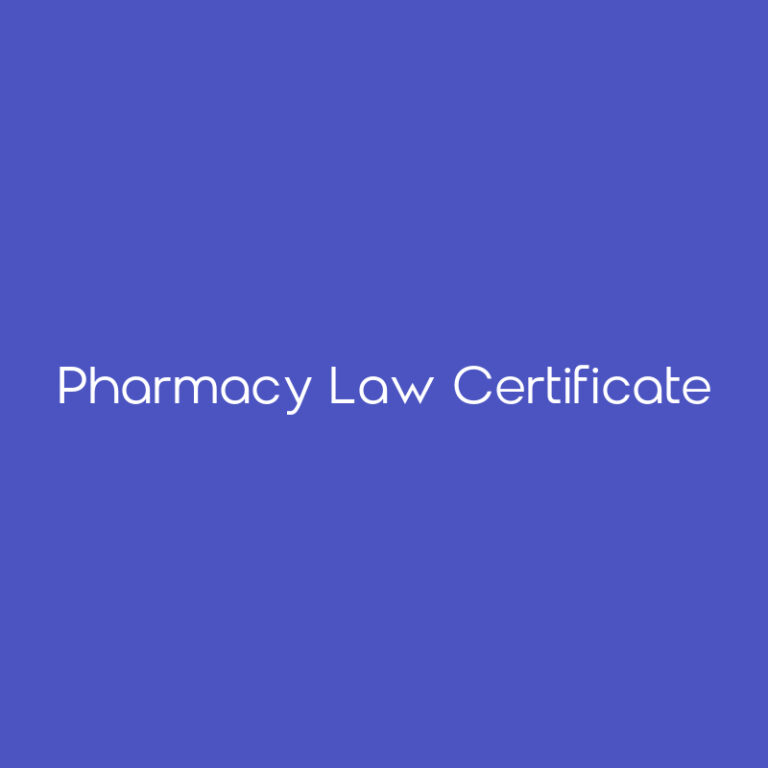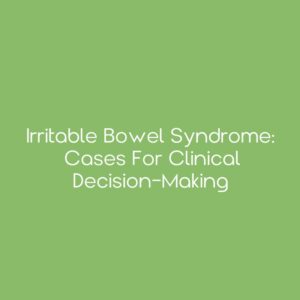Pharmacy Law Certificate

Pharmacy Law Certificate
This comprehensive program equips pharmacists with essential expertise in risk management, regulatory compliance, and legal frameworks to safeguard patient safety and professional integrity. Through two in-depth courses – Medication Malpractice and Lethal but Legal Medications – participants will earn the Pharmacy Law Certificate, positioning themselves as legal experts within their practice and enhancing career opportunities in regulatory compliance, consulting, and legal advising.
This course consists of 2 courses:
1. Medication Malpractice
2. Lethal But Legal Medications
Medication Malpractice
15 Hours | Written
This course provides a detailed exploration of pharmacy liability, offering pharmacists a comprehensive understanding of its intricate landscape. Through vivid case studies spanning international jurisdictions, learners will dissect multifaceted challenges encountered by pharmacists, from dosage errors to procedural oversights. After an extensive analysis of legal fundamentals and nuances related to pharmacy workflow, learners will gain a thorough understanding of negligence and liability within pharmacy practice. Moreover, course content will emphasize practical strategies for risk mitigation, empowering learners to navigate complex scenarios with confidence while prioritizing patient safety and professional integrity. With a focus on both theoretical knowledge and real-world application, learners will emerge equipped to uphold the exemplary standards of pharmacy practice and minimize the potential for malpractice.
Upon successful completion of this application-based CPE course, pharmacists should be able to:
1. Describe the elements of a plaintiff’s claim for punitive damages following a pharmacy dispensing error.
2. Discuss the role of an expert witness in a pharmacy malpractice lawsuit.
3. Explain how to avoid liability for punitive damages in a pharmacy malpractice lawsuit.
4. State the four essential elements of a pharmacist malpractice liability lawsuit.
5. Review the legal defenses that a pharmacist can present in a pharmacist malpractice liability lawsuit.
6. Explain the importance of the standard of care in a pharmacist malpractice liability lawsuit.
7. List the most common types of pharmacy practice errors that lead to legal claims of malpractice.
8. Summarize the legal basis for a pharmacy malpractice lawsuit.
9. Discuss techniques that can be implemented to reduce pharmacy errors and to avoid liability for pharmacy malpractice.
10. Describe the legal procedures for consideration of a pharmacy malpractice case by a court of law.
11. Discuss how a pharmacist can participate effectively in the process of malpractice litigation to promote a successful result.
12. Outline the process through which the civil justice system considers malpractice claims against a pharmacist or pharmacy.
13. Explain how malpractice liability may differ between institutional pharmacy practice and community pharmacy settings.
14. Review how errors in order processing can lead to malpractice liability within an organized healthcare system.
15. Identify strategies for institutional pharmacy practice to reduce potential exposure to malpractice liability.
16. Describe the evolution of a pharmacist’s duty to warn as legal precedent in pharmacy malpractice litigation.
17. Explain the difference between a generalized duty to warn and a specialized duty to warn.
18. Identify steps pharmacy risk managers can take to reduce exposure to malpractice liability for violating the duty to warn.
19. Recall the evolution of the pharmacist’s professional role as a provider of medication-related information to patients.
20. Articulate the basis of the “no generalized duty to warn” approach that has been recognized in pharmacist malpractice cases.
21. Describe the exceptions to the “no generalized duty to warn” approach that imposes liability on pharmacists for the failure to warn patients.
22. Summarize the potential hazards of using incautious language when engaged in patient counseling.
23. State the types of comments that might be made by a pharmacist to a patient that would expose the pharmacist to legal consequences.
24. Identify risk management strategies for reducing malpractice liability during pharmacist-led patient education.
25. Discuss the circumstances in pharmacy practice where patient counseling and prescriber consultation may be insufficient to meet the pharmacist’s standard of care.
26. Explain the difference between the duty owed to a patient and the standard of care in pharmacy in a pharmacist malpractice lawsuit.
27. Describe the legal expectations of pharmacists who are presented with a prescription that could be fatal to the patient.
28. List the requirements of dispensing pharmacists pursuant to the federal guidelines for Prospective Drug Use Review.
29. Recognize how pharmacists may be required to consult prescribers to resolve drug therapy problems beyond what patient counseling can address.
30. Discuss risk management strategies to prevent pharmacy malpractice liability for failing to effectively address harmful medication orders.
31. Define the concept of “corporate liability” and the role of hospital employees in the direct provision of care to hospital patients.
32. Explain how the pharmacy department can protect the hospital from liability by preventing adverse patient outcomes and fostering positive ones.
33. Describe the growing legal responsibilities of institutional pharmacists due to increased access to patient data and integration into the healthcare team.
34. List the types of comments in the patient care record that could lead to exposure to malpractice liability.
35. Explain the difference between necessary patient care record notations and comments that could imply a breach of the standard of care.
36. Outline strategies for the use of risk-sensitive language by pharmacists in patient care documentation.
37. Discuss the importance of expert witness reports in pharmacy malpractice litigation.
38. Explain the inferences that can be drawn by experts who evaluate pharmaceutical care without documented records.
39. Describe the exposure to malpractice liability that can be created by the failure of pharmacists to document their clinical care.
40. Indicate how a patient may become dissatisfied with pharmacy services due to a perceived personal affront.
41. Discuss effective strategies for identifying and managing potentially litigious patients upset due to personal antipathy toward a pharmacist or pharmacy.
42. Identify the types of situations that present controversies in pharmacy that can escalate into a litigious situation.
43. Explain the background of the patient safety movement and its relevance to pharmacy practice.
44. Discuss the basic principles of continuous quality improvement (CQI) as applied to the pharmacy practice setting.
45. Describe a procedure for creating a pharmacy CQI program that reduces the exposure of pharmacists and pharmacies to malpractice liability.
Lethal But Legal Medications
15 Hours | Written
This pharmacy law course explores the complexities and uncertainties surrounding legal medications, examining real-life instances where their use led to tragic outcomes despite adherence to regulatory standards. Through legal case studies, learners will gain insight into the challenges faced by healthcare professionals in mitigating risks associated with pharmaceutical products. Course content will highlight regulatory strategies for ensuring patient safety, addressing known risks, and navigating professional responsibilities in the face of uncertainty. This course also emphasizes the vital role of regulatory compliance and showcases the responsibilities of various regulatory bodies to provide the learner with a comprehensive understanding of the legal framework governing the practice of pharmacy.
Upon successful completion of this knowledge-based CPE course, pharmacists should be able to:
1. Discuss the three branches of government and the interrelationships between these three branches.
2. Explain the provisions of the Constitution of the United States and the applicability of those provisions to pharmacy practice.
3. Describe how market failures have been used by political scientists and economists to justify government action in the interests of the public.
4. Describe the professional responsibilities of healthcare professionals and institutions based on government-recognized public expectations.
5. Explain the diverse approaches to regulation adopted by government agencies to fulfill their obligations to the public.
6. Discuss how government agency dynamics can affect the need for flexible approaches to regulatory compliance aligned with agency goals.
7. Discuss the standards for new drug approval that are established under the federal Food, Drug & Cosmetic Act (FDCA).
8. Explain the statutory requirements for classification of a product as either a “drug” or as a “new drug.”
9. Describe the FDA’s authority to evaluate scientific evidence of pharmaceutical product safety and efficacy.
10. Summarize the FDA’s role in ensuring pharmaceutical product integrity under the FDCA, as amended by the Drug Supply Chain Security Act (DSCSA).
11. List factors that could significantly increase the risk of an illegitimate pharmaceutical product entering the drug supply chain.
12. Outline strategies for pharmacy compliance with the requirements established under the DSCSA.
13. Describe the role of the FDA in assuring safe drug use after a drug has been released for general marketing and use.
14 Review a program developed for the purpose of drug risk evaluation and mitigation.
15. Outline a systematic approach to ensure that patient information provided by pharmacists with medications is pursuant to relevant federal regulations.
16. List the factors that state regulations have established to assure safe, effective, and efficient generic medication substitution by pharmacists.
17. Discuss strategies to meet regulatory requirements in the provision of substituted generic drug products to patients.
18. Review the actions of pharmacists to determine whether legal standards have been met when substituting generic products for branded ones prescribed by their trade names.
19. Describe the breadth of the FDA concept of “misbranding.”
20. Explain how the FDA “deems” to be misbranding a variety of actions that are considered unlawful by the agency.
21. Explain how the FDA broadens the scope of misbranding to encompass various pharmacy activities beyond their apparent regulatory category.
22. State the current FDA position regarding the legality of off-label use and promotion.
23. Describe the significance of a drug package insert regarding the standard of care for a health professional.
24. Review a policy of manufacturer off-label promotion to determine whether the claims made are truthful and not misleading.
25. List the factors that created a regulatory environment in which the New England Compounding Center (NECC) tragedy occurred.
26. Describe a policy for regulatory compliance at a compounding pharmacy.
27. Review a program of compounding that complies with the post-NECC regulatory environment for compounding by pharmacists.
28. Discuss the responsibilities of pharmacists to honor valid opioid prescriptions and to decline invalid ones.
29. Explain how the concept of “red flags” can be used to identify concerns about opioid prescription legitimacy.
30. Describe a program for screening, assessing, and managing the risks of opioid prescription diversion.
31. List the requirements for nonprescription drugs under the FDCA as administered by the FDA.
32. Review situations in which pharmacists may have responsibilities to assist patients with the appropriate use of nonprescription drugs.
33. Outline a policy that assures patients receive assistance with nonprescription medication inquiries while upholding patient autonomy.
34. Discuss the available recourse for pharmacy personnel dismissed for refusing to administer vaccinations.
35. Review patient compensation claims arising from alleged vaccine-related harm following administration by a pharmacy.
36. Describe the legal consequences for pharmacy personnel who fail to comply with immunization administration policies.
37. Discuss the concept of “rights” and “responsibilities” of patients who receive products and services from pharmacists.
38. Review the claim that a patient has failed to meet the patient’s responsibility as the beneficiary of pharmaceutical products and services provided by a pharmacist.
39. Describe a policy for pharmacy practice that incorporates the shared responsibilities of pharmaceutical care providers and their patients.
40. List the responsibilities of a pharmacist-in-charge (PIC).
41. Discuss situations in which a PIC may face significant challenges in fulfilling their role.
42. Describe an effective approach to meeting the responsibilities of a PIC.
43. Discuss the role of courts in determining patients’ rights to demand drug therapies not available under hospital policies.
44. Describe the possible consequences for the healthcare system if patients were allowed to demand the use of medications that are not the standard of care.
45. Explain the difference between “freedom to” and “freedom from” within the context of a patient’s request for a specific medication.
David B. Brushwood, R.Ph, J.D.
Senior Lecturer, The University of Wyoming School of Pharmacy
Pharmacy Law Content Developer, CEimpact
David B. Brushwood has no relevant financial relationships with ineligible companies to disclose.
This program is provided for educational purposes. CEimpact is not a law firm and does not provide legal advice of any kind. For legal advice, please contact a licensed attorney.
This is not an ACPE-defined Certificate Program; learners who complete this course will receive ACPE CPE credit but will not be awarded completion of a Certificate Program.
Course fee includes course, course materials, and CPE credit submission to CPE Monitor.
Course is non-refundable.
Initial Release Date: March 17, 2025
Planned Expiration Date: March 17, 2028
Copyright 2025, CEimpact. All Rights Reserved. Any reproduction of this course without express permission is strictly forbidden.
![]() CEImpact is accredited by the Accreditation Council for Pharmacy Education as a provider of continuing pharmacy education. Obtain CPE credit by completing the course, followed by the exam and evaluation (if applicable). Once successfully completed, your course will appear in your Completed Courses tab. Access your CPE statement of credit at www.MyCPEMonitor.net.
CEImpact is accredited by the Accreditation Council for Pharmacy Education as a provider of continuing pharmacy education. Obtain CPE credit by completing the course, followed by the exam and evaluation (if applicable). Once successfully completed, your course will appear in your Completed Courses tab. Access your CPE statement of credit at www.MyCPEMonitor.net.
¹CEImpact provides you with two (2) opportunities to complete the exam. The learner will not receive CPE credit after two failed attempts.
Additional information
| Duration | 30h 0m |
|---|---|
| Topic Designator | Law |
| ACPE | Yes |
| ACPE Topic | 03 Law |
| Role | Pharmacist |
| Media-Type | Written |
| Release Date | 3/17/25 |
| CEUs | 3 |
| ACPE Number | 0107-0000-25-124-H03-P |



![Advances in ADHD Treatment [Pharmacist]](https://www.ceimpact.com/wp-content/uploads/course-images-solidbg/2022/06/pharmacist/4547-300x300.jpg)
